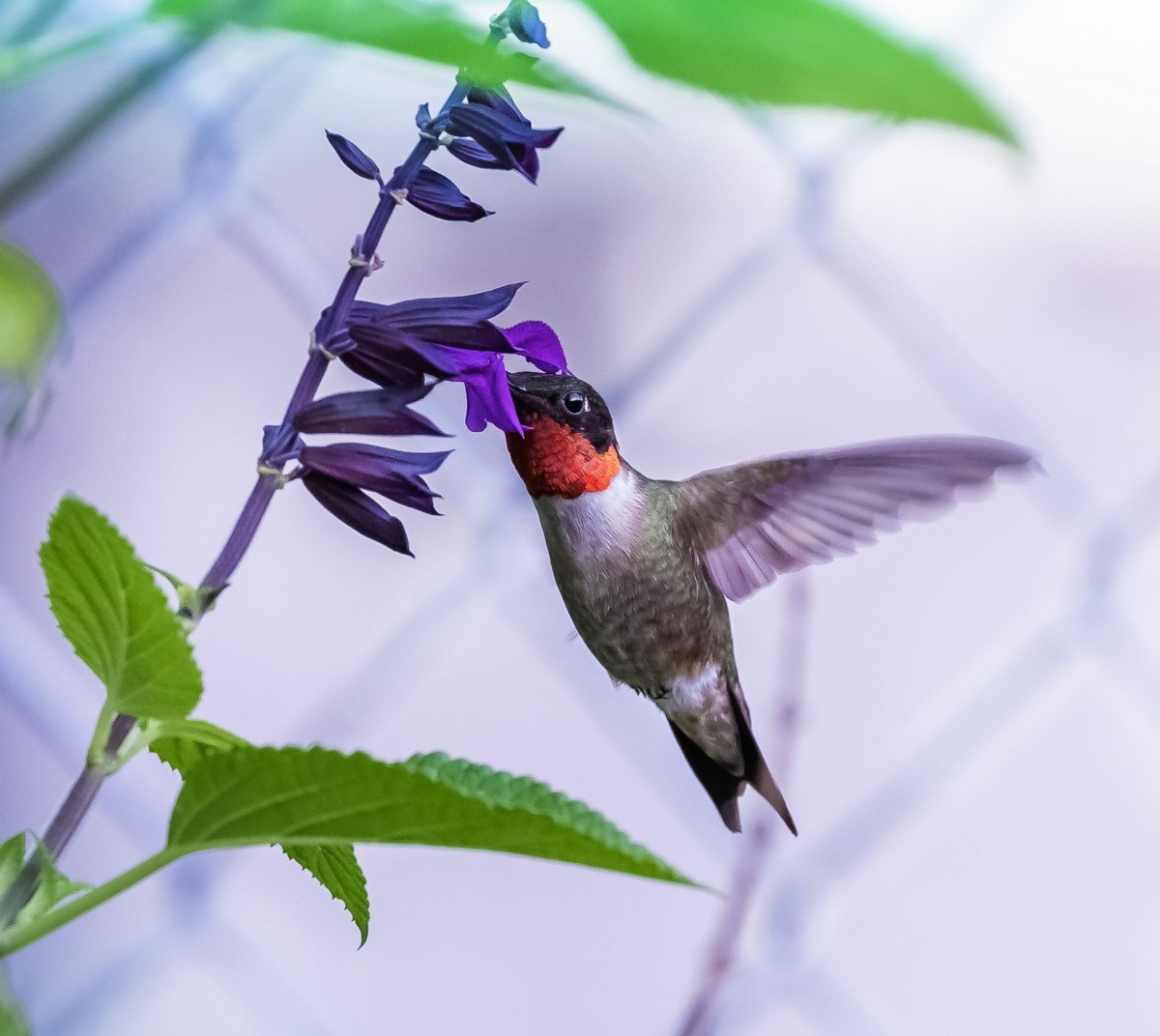This post contains affiliate links.
Georgia, known as the peach state, is located in the southeastern region of the United States, consisting of coastal, farmlands and mountains. Georgia is surrounded by Tennessee on the north, Florida on the south, South Carolina and the Atlantic Ocean on the east and Alabama on the west.
The state of Georgia experiences the traditional four seasons of winter, spring, summer and fall; with extremely hot and muggy long summers and cold and wet winters.
What types of hummingbirds are found in Georgia?
- There are 11 species of hummingbirds found in Georgia.
- Year-round natives: None
- Seasonal: Ruby-throated, Rufous.
- Rare/Vagrant: Allen’s, Anna’s, Black-chinned, Broad-billed, Broad-tailed, Calliope, Green-breasted mango, Rivoli’s, Green-violetear (Mexican-violetear).
Categories of Hummingbirds
Year-round/Native Hummingbirds
This hummingbird classification is defined as hummingbirds residing in a group in Georgia 365 days a year and do not migrate.
None
Seasonal Hummingbirds
These hummingbirds are in Georgia temporarily as part of their migratory pattern. Some of these species spend either a season or the entire spring, summer, fall or winter in Georgia.
- Ruby-throated
- Rufous
Rare/Vagrant Hummingbirds
This hummingbird classification is defined as hummingbirds residing in a group outside of their normal geographic range when found in Georgia. Not only do these species of hummingbirds have a wide variety of specific geographic ranges, they are also known to sometimes interbreed with each other, creating hybrids.
- Allen’s
- Anna’s
- Black-chinned
- Broad-billed
- Broad-tailed
- Calliope
- Green-breasted mango
- Rivoli’s
- Green-violetear (Mexican-violetear)
The vast multitude of diversified hummingbird species found in Georgia are sighted during the winter season. The large concentrations of hummingbirds typically are juvenile male and female hummingbirds that migrate. At first glance, clear identification is difficult due to the masses all looking the same in their adolescent stages.
Both ornithologists and bird watchers use collective nouns or flock names to describe a large group of hummingbirds of the same species. The scientific term for a group of hummingbirds is “charm”. Other names include bouquet, glittering, shimmer, tune or hover.
Read on to find out more about each of these hummingbird species as well as where and when they can be found in Georgia.
Year-round/Native Hummingbirds
None
Seasonal Hummingbirds
RUBY-THROATED HUMMINGBIRD – (Archilochus colubris)
Conservation Status: Least concerned
Kingdom: Animalia
Phylum: Chordata
Class: Aves
Order: Apodiformes
Family: Trochilidae
Genus: Archilochus
Species: A. colubris
The Ruby-throated hummingbird’s scientific name originated from Carl Linnaeus, a Swedish botanist, who first listed this scientific classification as “Trochilus colubris”. It’s name changed over a hundred years later and was reclassified by Ludwig Reichenbach, a German botanist to “Archilochus colubris”, which is its current scientific name, meaning “top thief” or “sky spirit/sun-god bird”.
Male Ruby-throated hummingbirds have a striking iridescent blood-red gorget, stopping at the neckline. He is identified with a dull metallic green topside, a light gray underbelly and black wings. The Ruby-throated hummingbird is a smaller species of hummingbirds weighing less than 4-½ grams or 2 U.S. dimes and is 2.8 to 3.3 inches in length. Their lifespan is approximately 5 years.
The gorget on a male hummingbird is named after the protective metal piece in a suit of armor that covers the wearer’s throat to prevent injury when in battle.
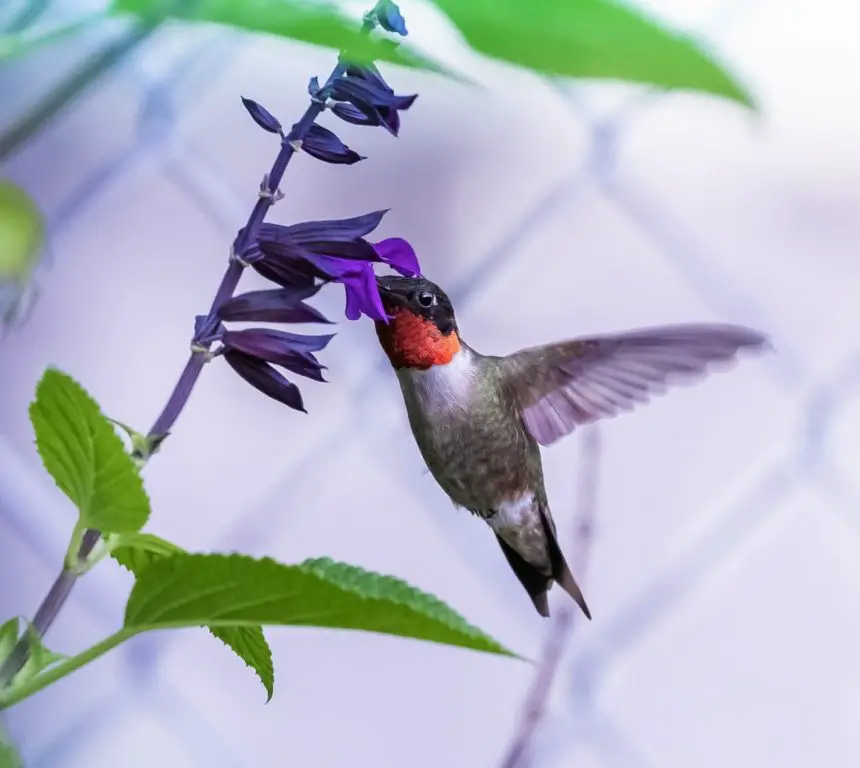
Plant: Friendship Sage – Salvia ‘Amistad’
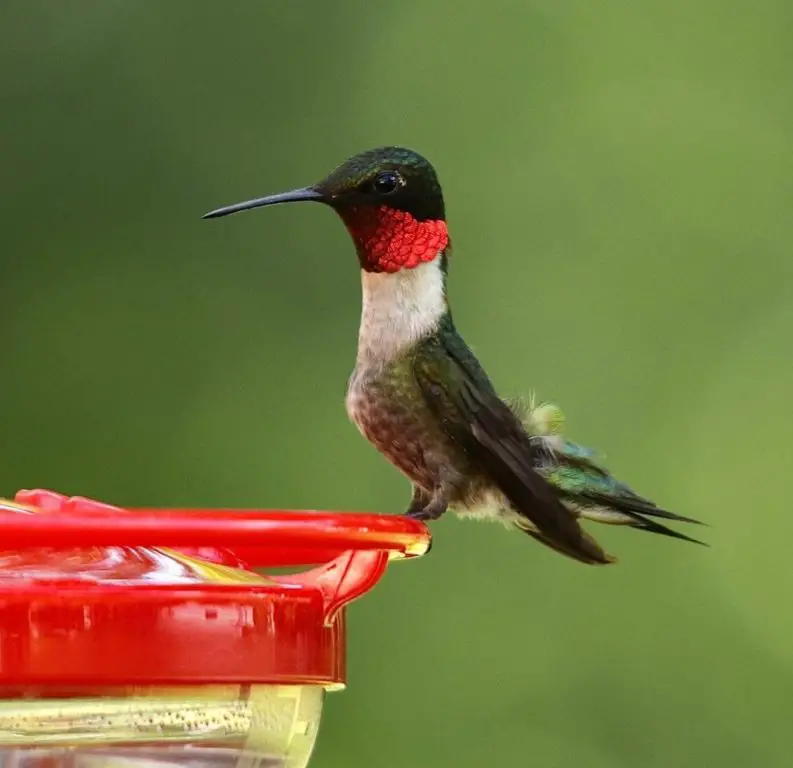
Photo by: dgen.photos
Since male hummingbirds are extremely aggressive with each other when fighting for their own territory, this name is appropriate and fitting to describe their physical attributes.
Female Ruby-throated hummingbirds have a white throat with some light stippling and are typically larger than the males. Their lifespan is approximately 9 years, almost double that of the male.
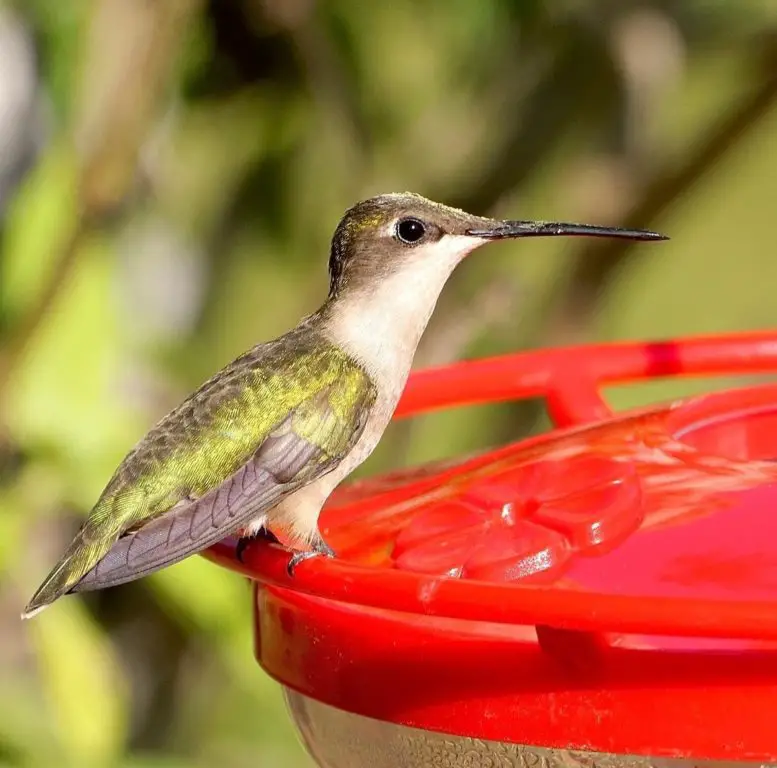
Photo by: Dgen.photos
According to the Georgia Department of Natural Resources, Ruby-throated hummingbirds are the only species of hummingbirds that nest in Georgia east of the Mississippi River. They breed throughout the eastern United States as far west as eastern Texas, Oklahoma and up north to Minnesota.
Their spring breeding migration to Georgia from the south can begin as early as February while their nesting season begins in April. The males arrive first and then the females follow two weeks behind. During the spring and summer, the females nest and care for their young, and can produce up to two broods a year. By mid October, they leave to migrate south to Mexico. Their wintering range includes South Florida, Mexico and Panama.
There are two schools of thought on the migration population of Georgia Ruby-throated hummingbirds. One school of thought states that the Ruby-throated hummingbirds are migrants because they visit Georgia for a few months to breed while the other school of thought states that they are year round residents because they have been spotted throughout the year.
The Appalachian Trail is one of the oldest United States National Scenic series of pathways spanning 2,180 miles between Maine and Georgia crossing through 14 states. It is a critical and conservationally protected migration path for many birds.
Georgia’s 78.6 mile length of the Appalachian Trail begins at Springer Mountain located in the Chattahoochee National Forest above Atlanta and along the Georgia-Tennessee border.
According to the Georgia Department of Natural Resources, Georgia’s location is along a migratory route that ensures seasonal wildlife, including the Ruby-throated hummingbirds.
There are two southern migration routes for the Ruby-throated hummingbird.
The first route is the shortest but exhausting nonstop direct journey from the Mississippi Delta or the tip of Florida to the Mexican Yucatan peninsula over the Gulf of Mexico. This distance is over 500 miles. Although this is the direct or “short” route, there are numerous obstacles faced by these hummingbirds.
The tropical Atlantic hurricanes pose life threatening challenges as these hummingbirds fly to their destination. There are no respite areas during their journey for them to refuel and rest during their migration. Once they commit to this direct route, they will either be successful or perish. To make matters worse, part of their migration is taking the “Red-eye flight” which is during the dark hours of the night.
Researchers believe their small size makes the energy expenditure of their grueling trans-oceanic migration journey more taxing for males than for females even though they both double their body’s fat content prior to making the migration across the Gulf of Mexico.
The second migration route from the Mississippi Delta to the Mexican Yucatan peninsula is flying along the coastline which outlines the Gulf of Mexico and is the “long” route and consists of over 2,000 miles or 4 times the distance of the direct route. It allows them the opportunity to rest and refuel even though there may be less guaranteed food sources along the way.
Scientists are unclear and continue to investigate as to why one group of birds would prefer to take one route over the other.
Ruby-throated hummingbirds prefer:
- Open woodland forests
- Bottomlands near rivers with thick evergreen shrubs and trees
- Parks
- Gardens
- Backyards
They enjoy drinking from Salvias, Cardinals, Trumpet vines, Coral honeysuckle and Friendship Sage. They are solitary birds except during mating periods when they are fiercely territorial and aggressive towards hummingbirds of other species.
Though these hummingbirds exhibit an aggressive nature they can still be eaten by predators such as large invertebrates, praying mantises, orb-weaver spiders, and dragonflies.
See pictures of male, female, and juvenile Ruby-throated hummingbirds here…..
Hear sounds of Ruby-throated hummingbirds here…..
RUFOUS HUMMINGBIRD – (Selasphorus rufus)
Conservation Status: Near threatened
Kingdom: Animalia
Phylum: Chordata
Class: Aves
Order: Apodiformes
Family: Trochilidae
Genus: Selasphorus
Species: S. rufous
The Rufous hummingbird gets its name from the Latin word rubrum meaning “red” that is used to describe its reddish-brown coloring.
The Rufous hummingbird is considered the second most sighted hummingbird in Georgia even though they are mainly a west coast migrant. Their breeding territory has been documented as ranging from Alaska through Washington, Oregon, Montana and into Idaho.
According to the Georgia Department of Natural Resources, Rufous hummingbirds are the most commonly seen wintering hummingbird in Georgia. During one winter there were over 100 Rufous hummingbirds sighted and documented. Therefore it is highly recommended to keep at least one feeder available during the winter to accommodate these hummingbirds.
To learn more about hummingbird survival during the winter months, see both of my articles below.
See my article: Should I Keep My Hummingbird Feeder Out During the Winter?
See my article: 11 DIY Ways to Keep Hummingbird Nectar From Freezing
Male Rufous hummingbirds display an iridescent orange-red gorget with rusty-colored flanks and tail. They have a white to beige underbelly and a black bill. Males can also have green plumage with specks of green color on their rustic looking backs or on the crown of their head along with chocolate brown dorsal feathers. Their size is 2.8 inches to 3.5 inches in length and weigh 3.2 grams.
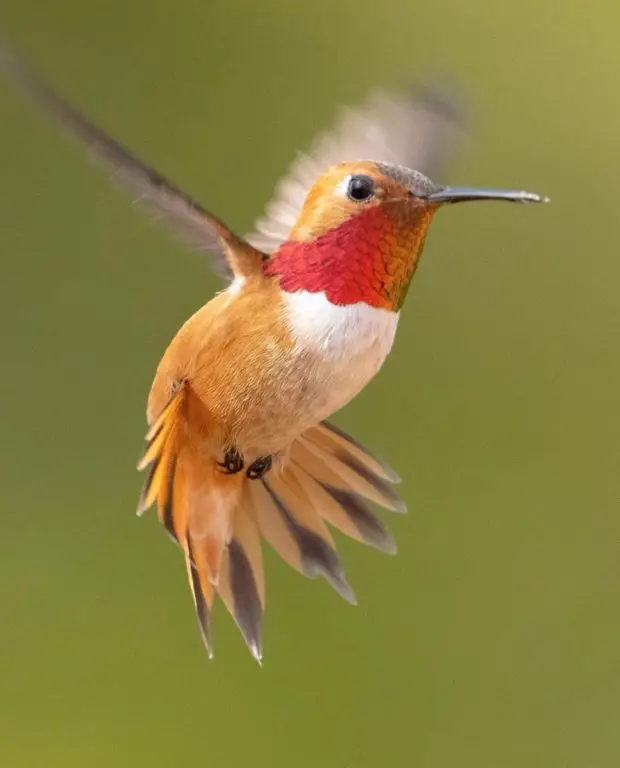
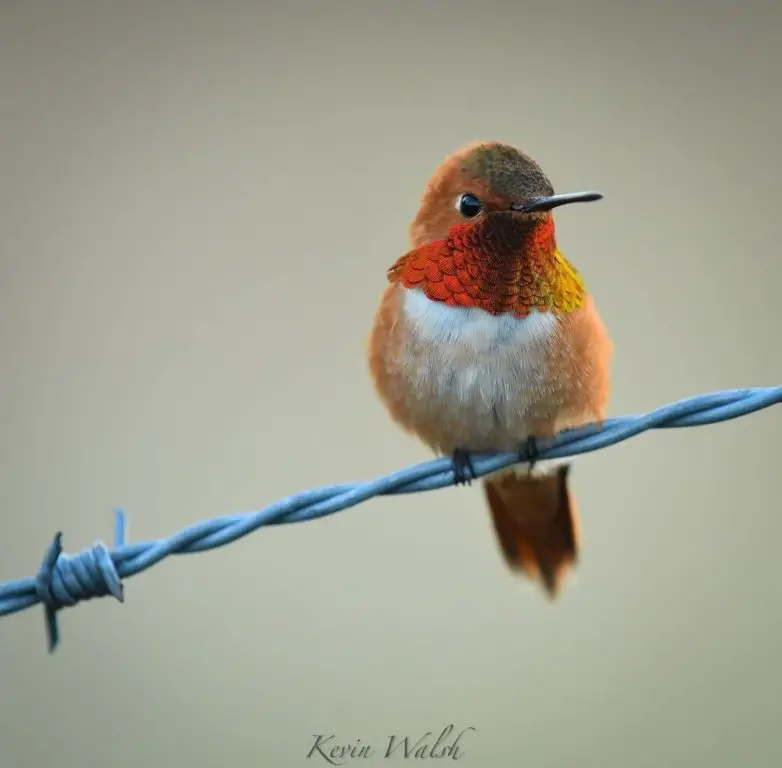
Photo by: Kevin Walsh
Immature male Rufous hummingbirds have a rustic look with small iridescent orange specks of color on their throats.
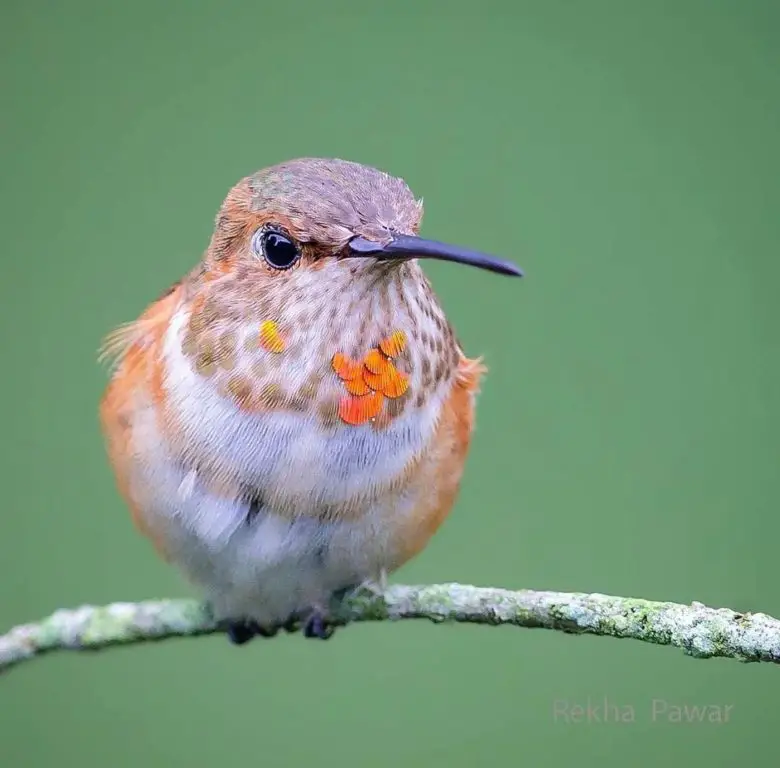
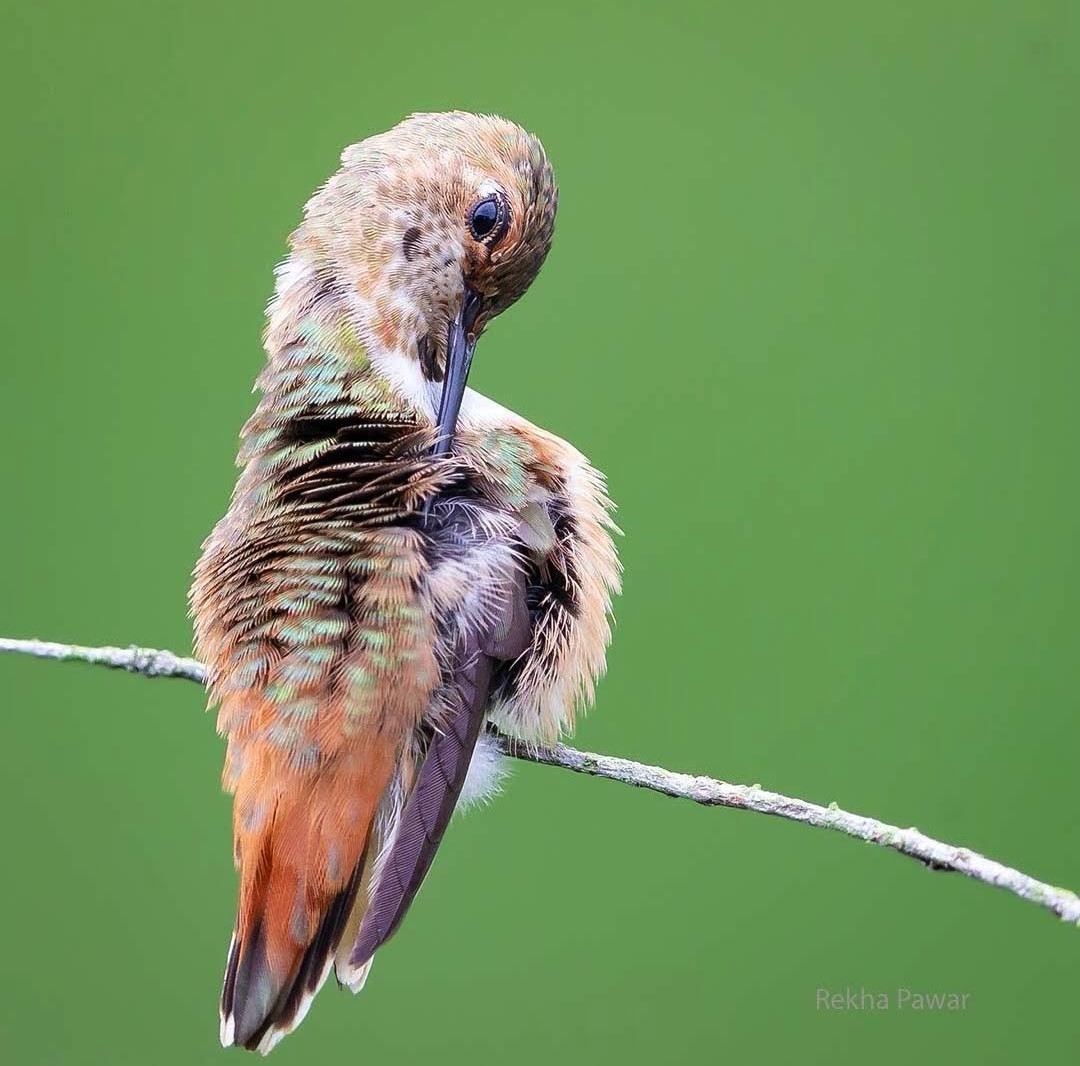
Photo by: Rekha Pawar
Female Rufous hummingbirds are green and white with some iridescent orange feathers on their throat. Their tail is dark with white tips and an orange-red base. Female Rufous hummingbirds are slightly larger than the males in anticipation of producing offspring.
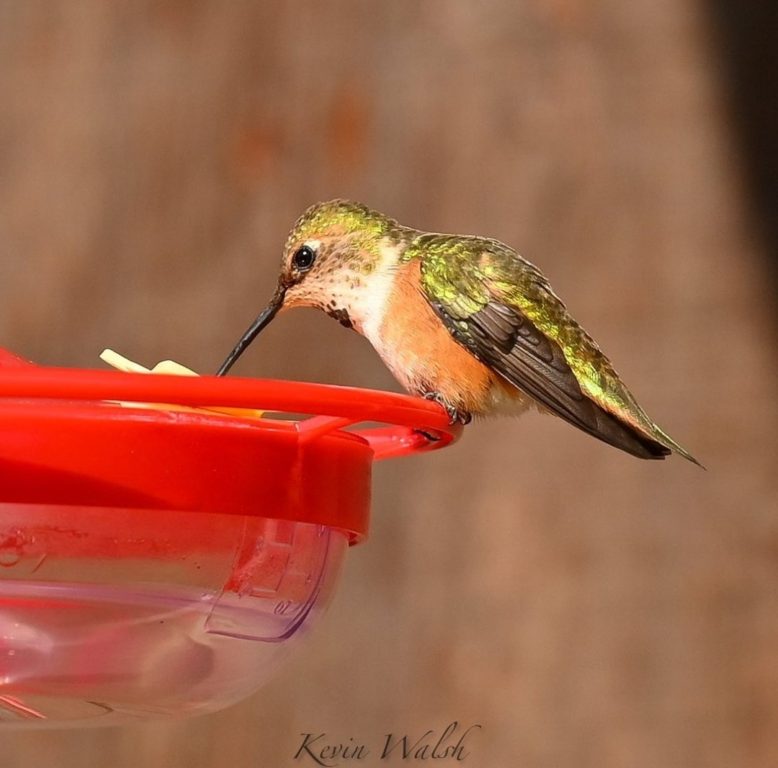
Photo by: Kevin Walsh
Rufous hummingbirds are highly territorial and are aggressive towards other hummingbirds and animals. They have been known to even attack squirrels and chipmunks that come too close to their nest. Their flying acrobatic skills will outmaneuver all other hummingbird species, making them extremely competitive at feeders.
Rufous hummingbirds have excellent memories and have been known to investigate the location of an old hummingbird feeder years after the feeder has been removed.
During a capture and release banding operation in British Columbia, the oldest living recorded female Rufous hummingbird was 8 years and 11 months old.
See my article: 3 Reasons Why Hummingbirds Are Banded
Due to habitat loss in the Pacific Northwest, Rufous hummingbirds were listed at “near threatened” status by the IUCN red list of threatened species in 2018.
See pictures of male, female and juvenile Rufous hummingbirds here…..
Hear sounds of Rufous hummingbirds here…..
Rare/Vagrant Hummingbirds
ALLEN’S HUMMINGBIRD – (Selasphorus sasin)
Conservation Status: Least concerned
Kingdom: Animalia
Phylum: Chordata
Class: Aves
Order: Apodiformes
Family: Trochilidae
Genus: Selasphorus
Species: S. sasin
The common name of Allen’s hummingbird is in commemoration of Charles Andrew Allen (1841-1930), an American collector and taxidermist.
Allen’s hummingbirds are rarely seen wintering in Georgia and are considered a vagrant. Less than 12 sightings have been documented as of 2011. The rare sightings are due to the hummingbird getting lost during migration since it is considered a west coast bird.
This species is often mistaken with the Rufous hummingbird due to its colors however the best way to identify the difference is that the Rufous has a bronze back and the Allen’s has a green back.
Male Allen’s hummingbird shows an iridescent orange-red gorget. They are green backed with a green forehead and rust-colored flanks, rump, and tail. When their tail feathers are fanned out you can see their chocolate-colored tips. Allen’s hummingbirds are 3.3 inches to 3.5 inches in length and weigh 2-4 grams.
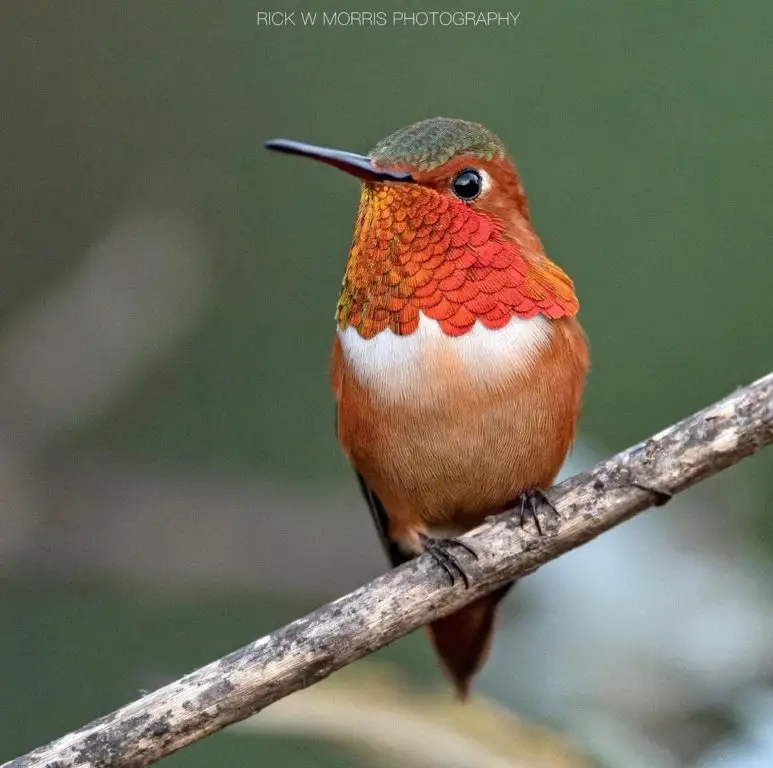
Photo by: IntheWildwithRick
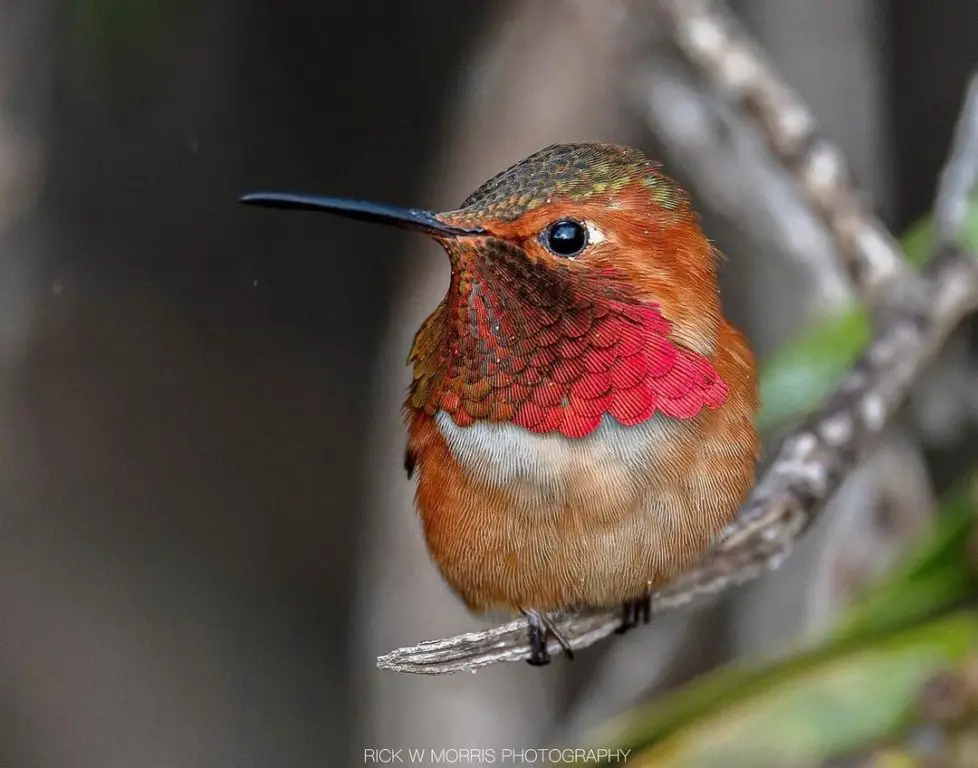
Photo by: IntheWildwithRick
Females and juveniles Allen’s hummingbird have similar coloring as the males, but lack the iridescent gorget.
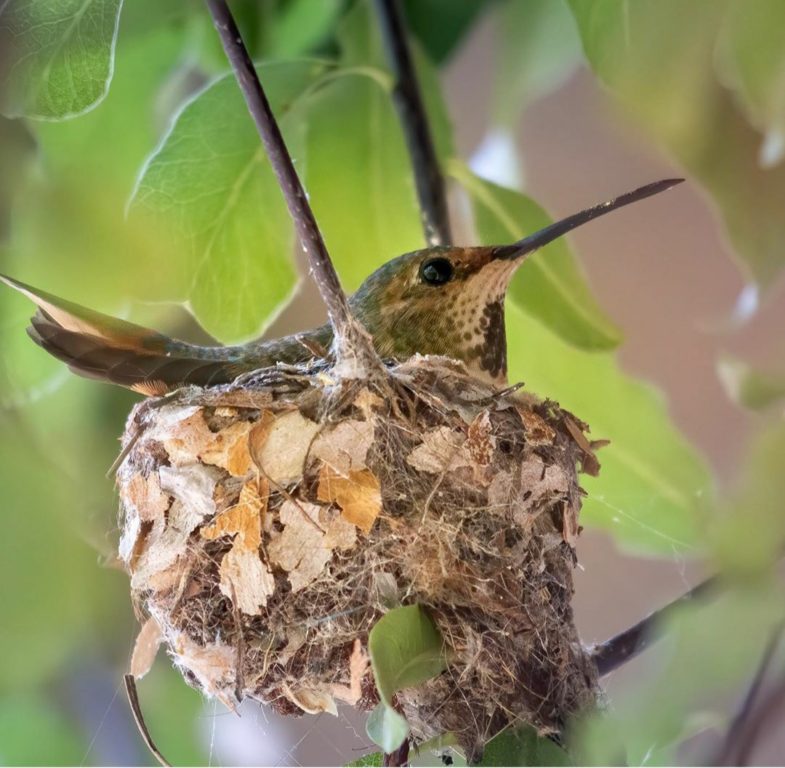
Photo by: aarongomperts
See my article: Hummingbird Parents: (Mating to Nesting)
See my article: Baby Hummingbirds: (Egg to Fledgling)
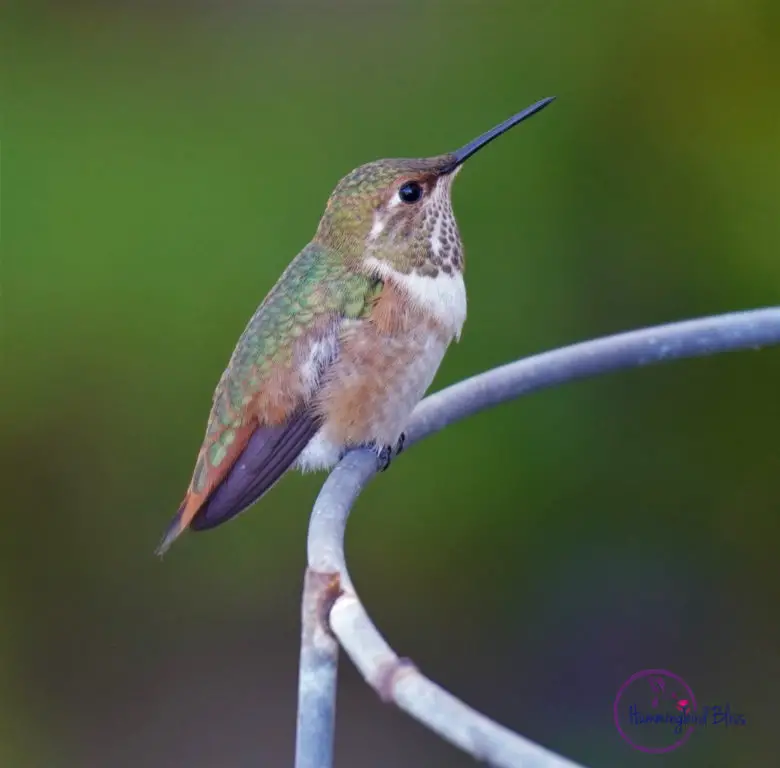
Baby Allen’s hummingbirds are easily identified by their white fluffy feathers near their bottom that will disappear as they age.
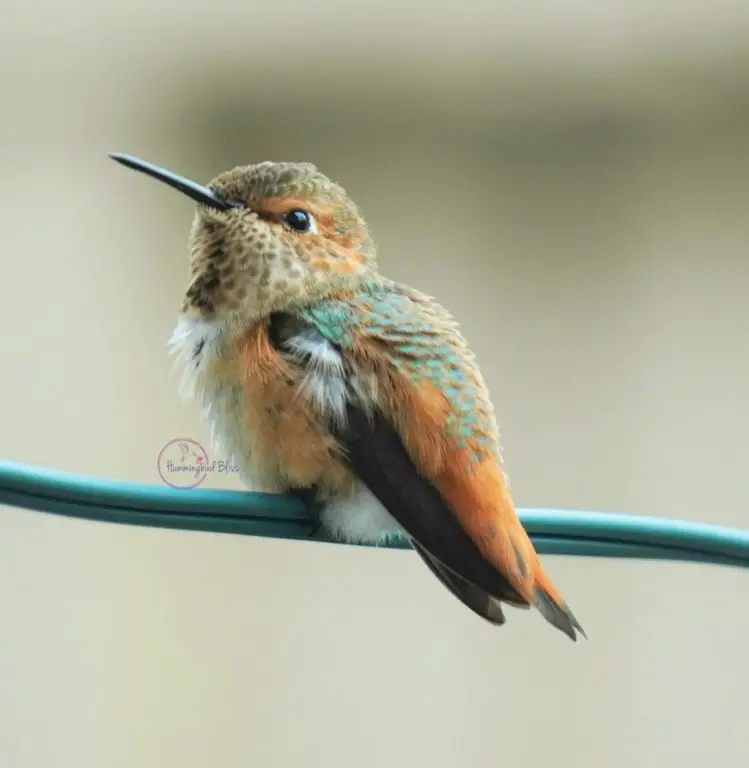
Juvenile Allen’s hummingbirds are so similar in coloring and temperament to a Rufous hummingbird that they are practically indistinguishable in the field. Therefore, identification is established by range rather than appearance.
Male Allen’s hummingbirds perform a striking, quick back-and-forth courtship dance resembling the movement of a pendulum. They have one of the most complex territorial dive displays of any North American hummingbird.
See my article: Hummingbird Dance: 5 Interpretive Explanations…..
Male and female Allen’s hummingbirds are not social birds and do not associate with one another outside of breeding. Similar to a Rufous hummingbird, Allen’s hummingbirds are highly territorial and can be aggressive not only towards other hummingbirds but will attack any species even larger predatory birds such as hawks.
Their habitat consists of open woodlands, dry chaparral vegetation consisting of dense shrubs, thorny bushes and riparian wetlands.
Allen’s hummingbirds are absent in mountainous elevations above 9,000 feet due to the lack of hummingbird flowers that would otherwise serve as their nectar source.
See pictures of male, female and juvenile Allen’s hummingbirds here…..
Hear sounds of Allen’s hummingbirds here…..
ANNA’S HUMMINGBIRD – (Calypte anna)
Conservation Status: Least concerned
Kingdom: Animalia
Phylum: Chordata
Class: Aves
Order: Apodiformes
Family: Trochilidae
Genus: Calypte
Species: C. anna
Anna’s hummingbirds are named after Anna Massena, Duchess of Rivoli. They are a rare vagrant hummingbird identified in Georgia. To date there have been 3 reported sightings of the Anna’s hummingbird. The rare sightings are due to the hummingbird getting lost during migration since it is considered a west coast bird.
Their breeding range is predominantly on the west coast including Washington, Oregon, California and Arizona.
Male Anna’s hummingbirds display a colorful iridescent magenta gorget and crown. They are the only hummingbird species in North America with a red crown. They are identified as mostly green, gray, and magenta in color. Their size ranges from 3.5 inches to 4.3 inches in length and weighs 2.4 to 4.5 grams.
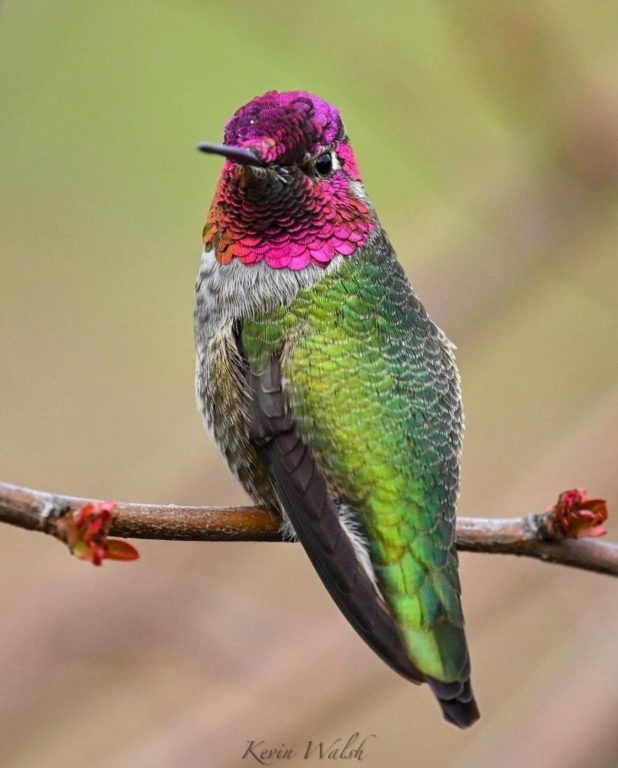
Photo by: Kevin Walsh
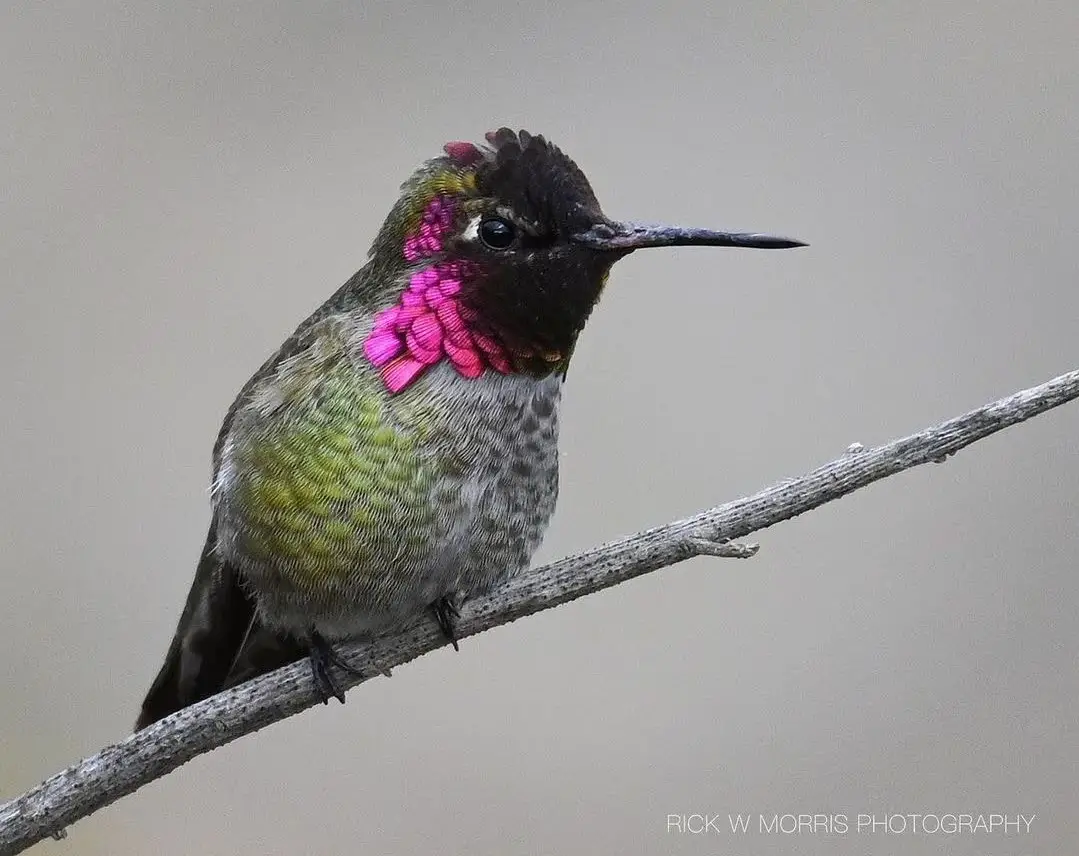
Photo by: IntheWildwithRick
Female Anna’s hummingbirds are pale green and are not as colorful as the males. They have a distinctive pale white line over each eye which is an identifiable trait.
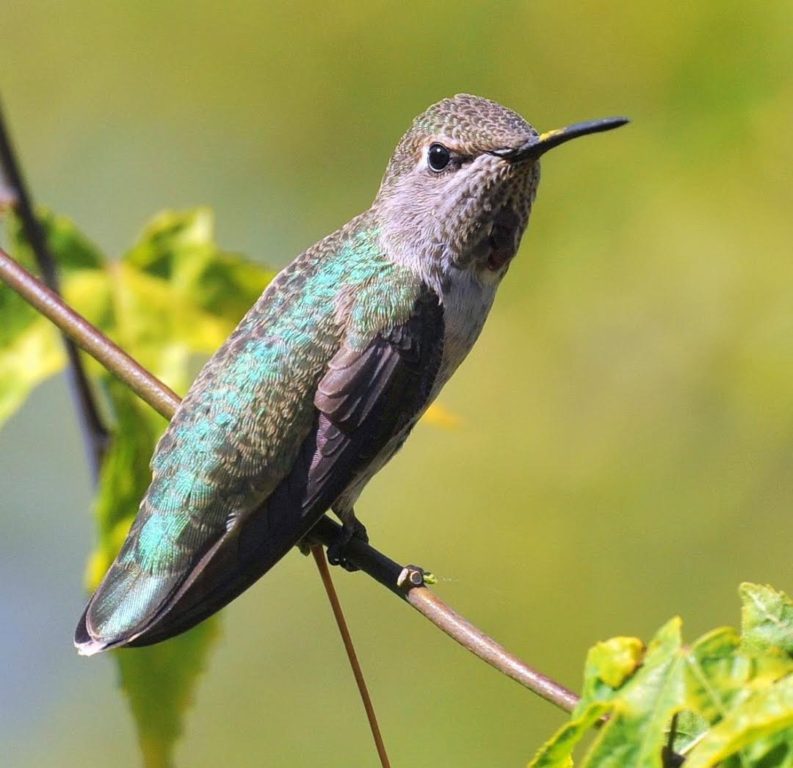
Photo by: IntheWildwithRick
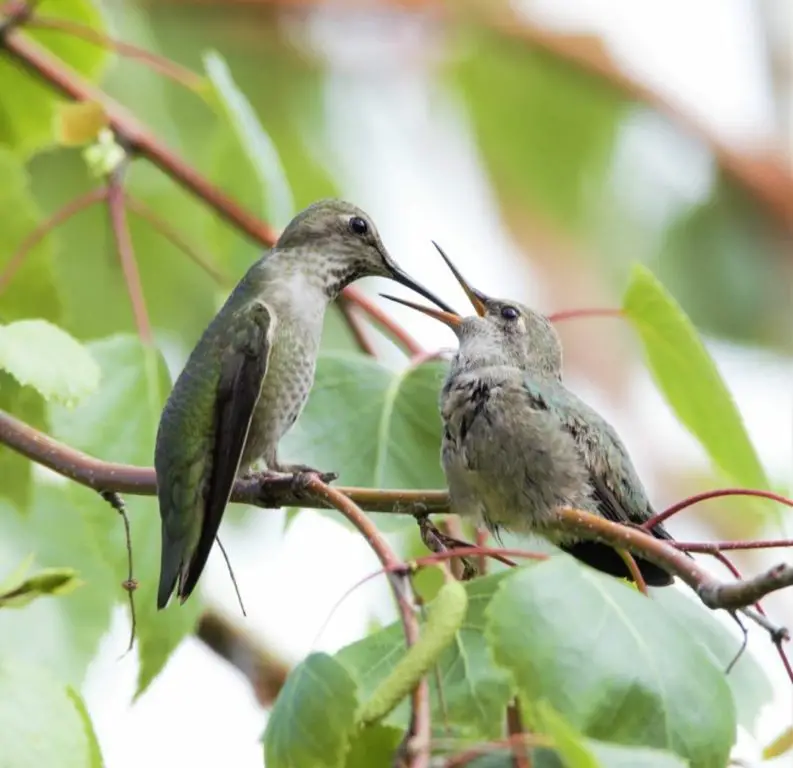
Photo by: Mehta.vishal.360
See my article: Hummingbird Parents: (Mating to Nesting)
See my article: Baby Hummingbirds: (Egg to Fledgling)
Juvenile Anna’s hummingbirds, both male and female, look more like adult females until they are differentiated as the male begins to acquire the bright red/magenta gorget.
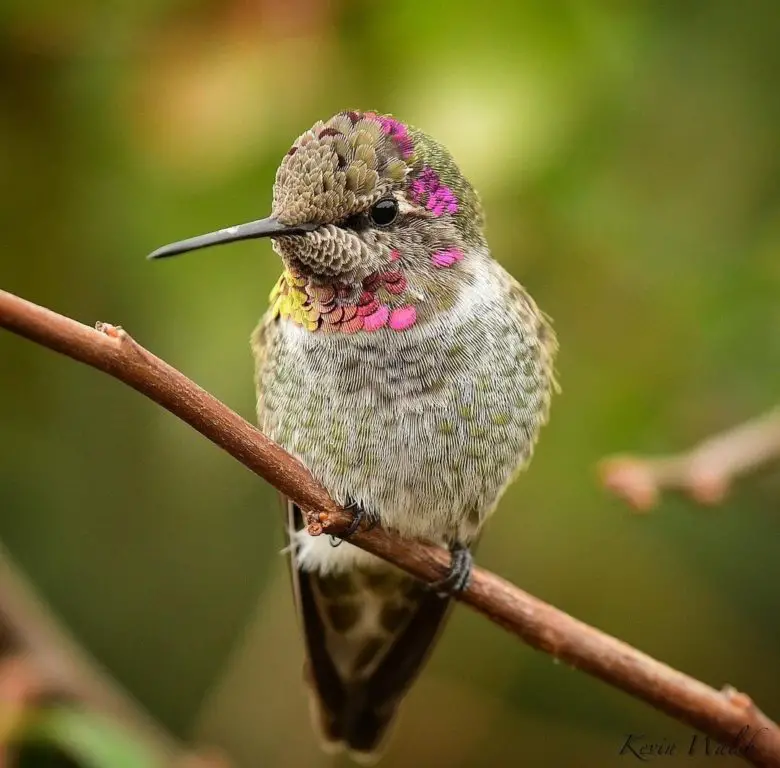
Photo by: Kevin Walsh
Note: This Anna’s hummingbird could be a juvenile in those awkward teenage years or it could be during a molting stage.
Baby Anna’s hummingbirds are easily identified by their white “fluffy butt” feathers that will disappear as they age.
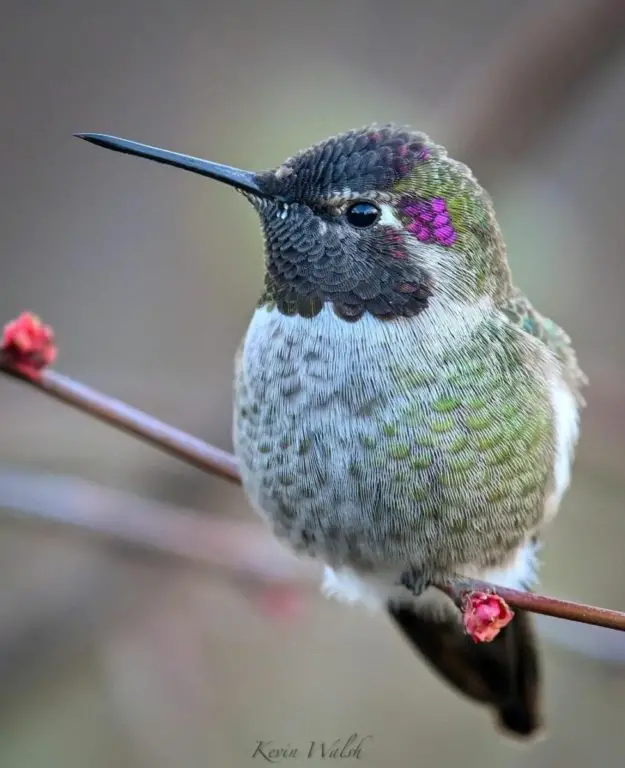
Photo by: Kevin Walsh
Note: This baby/juvenile male Anna’s hummingbird is beginning to show his magenta head feathers near his temple along with some faint color starting to show on his gorget. Also, notice the newly white fluffy down feathers near his bottom as well as the nice fat reserves he has accumulated by being fed by his diligent mother.
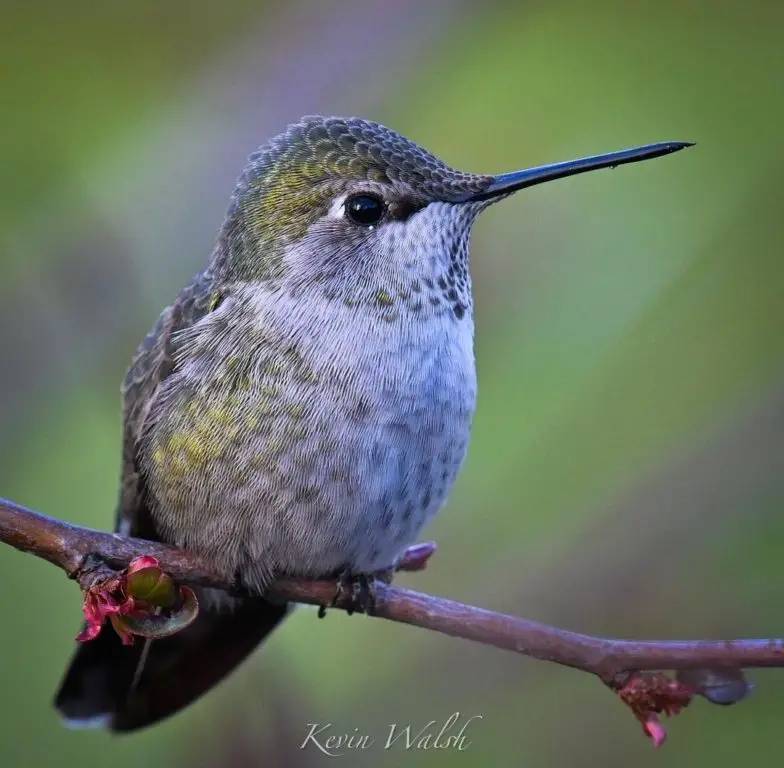
Photo by: Kevin Walsh
Unlike many northern temperate hummingbirds, male Anna’s hummingbirds sing a high-pitched and squeaky song during courtship.
Female Anna’s hummingbirds raise their young with no help from the males. Anna’s hummingbirds are commonly found nesting in Northern California climate ranges.
Like Black-chinned hummingbirds, Anna’s hummingbirds hybridize, cross breeding readily with other hummingbird species.
See pictures of male, female and juvenile Anna’s hummingbirds here…..
Hear sounds of Anna’s hummingbirds here…..
BLACK-CHINNED HUMMINGBIRD – (Archilochus alexandri)
Conservation Status: Least concerned
Kingdom: Animalia
Phylum: Chordata
Class: Aves
Order: Apodiformes
Family: Trochilidae
Genus: Archilochus
Species: A. alexandri
Black-chinned hummingbird’s scientific name is in commemoration of Dr. Alexandre, a French doctor who was the first to discover this species in Mexico.
They are a rare wintering vagrant hummingbird identified in Georgia. To date there have been only 5 reported sightings of the Black-chinned hummingbird each winter.
During migration, they travel south to winter in Mexico. If they are sighted in Georgia, most likely they have gotten lost and have taken a detour while migrating.
Male Black-chinned hummingbirds are identified by a royal purple gorget, showing a small glimmer of color right near the neckline mimicking a buttoned-up shirt. Since the male purple gorget or throat color is minimal, at times it will appear to look all black. These hummingbirds have a metallic green on their backs and flanks and sport a white underbelly. Their dark tail is forked and the bill is black. Their size is 3.25 inches to 3.5 inches in length and weigh 2.8-5.6 grams.
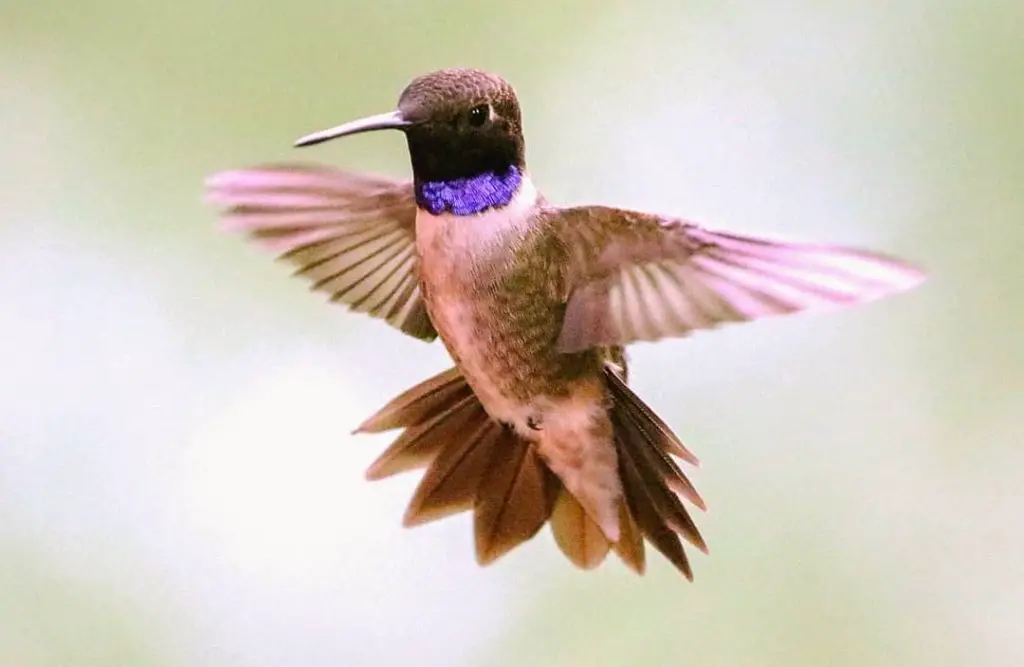
Photo by: bird.whisperer
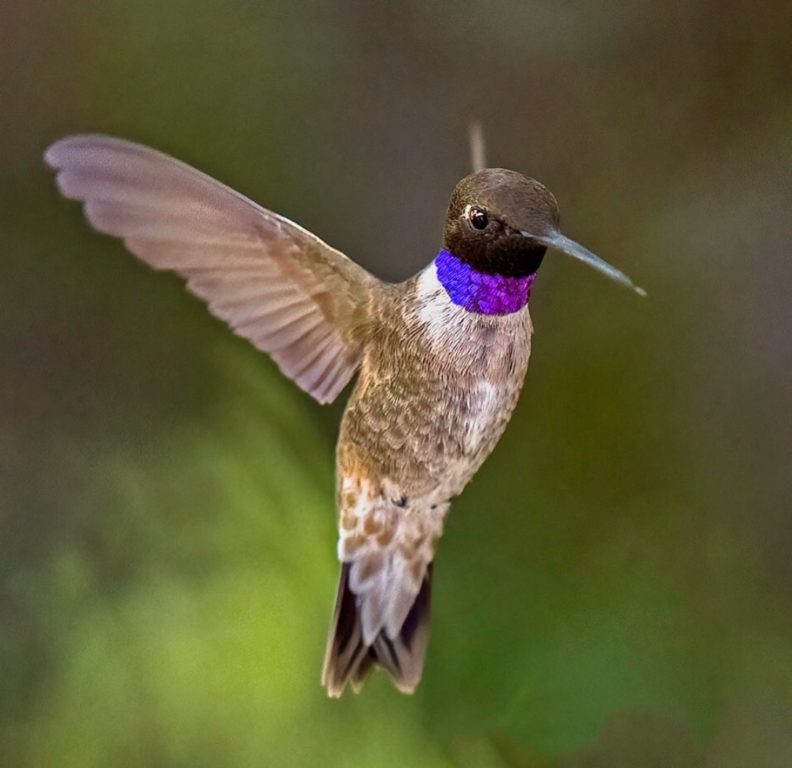
Photo by: sony_alpha_male
Female juvenile Black-chinned hummingbirds have no gorget. They have a dark rounded tail with white tips and beige margins on the dorsal feathers that turn dark black as they mature. Their head and back reflect the dull metallic marbled colors of beige, greens, whites, yellow-green and dark browns.
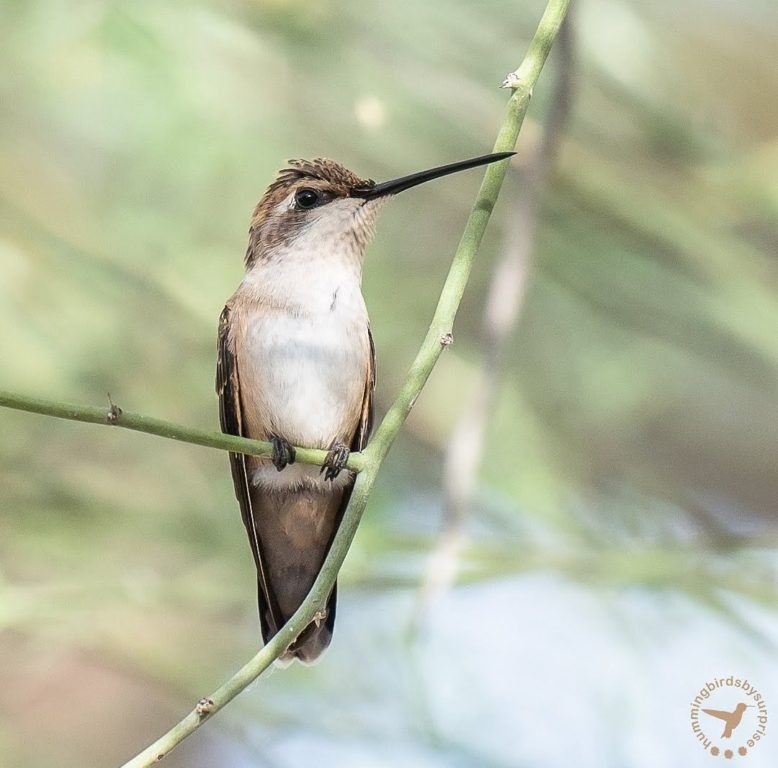
Photo by: hummingbirdsbysuprise
Baby Black-chinned hummingbirds are easily identified by their white fluffy feathers that will disappear as they age.
Black-chinned hummingbirds hybridize and readily crossbreed with other hummingbird species. Black-chinned hummingbirds can live up to 10 years, which is extremely long in comparison to other birds and animals of similar size.
Their breeding grounds and habitat are closely related to the Ruby-throated hummingbird which include open woodlands, parks, gardens and backyards.
Because of their small size, Black-chinned hummingbirds are at risk of being preyed-upon by larger insect-eating birds. Black-chinned hummingbirds are known to make their nests near large, active bird nests, reducing the chance of predators around the nest by using a decoy strategy.
While typically a territorial species, if Black-chinned hummingbirds find themselves in an area with a large population of hummingbirds and food sources of plenty, their territorial behaviors will be less aggressive and they will share.
Black-chinned hummingbirds have the smallest known genetic material of all living vertebrates or mammals.
See pictures of male, female and juvenile Black-chinned hummingbirds here…..
Hear sounds of Black-chinned hummingbirds here…..
BROAD-BILLED HUMMINGBIRD – (Cynanthus latirostris)
Conservation Status: Least concerned
Kingdom: Animalia
Phylum: Chordata
Class: Aves
Order: Apodiformes
Family: Trochilidae
Genus: Cynanthus
Species: C. latirostris
Broad-billed hummingbirds are accidental vagrants to Georgia. Most of this population stays year-round in Mexico and Central America. They are known to frequently travel north to the southern parts of the United States for the day, then return home to Mexico.
To date according to the Georgia Department of Natural Resources, there has only been one recorded sighting of an adult male in Macon-Bibb county, Georgia. He was sighted wintering in the backyard in Macon between 2001 and 2002.
Male Broad-billed hummingbirds feature a bright blue-green gorget that spreads back towards its shoulders. Juvenile males show off a full charcoal dark grey body with flecks of metallic blue on their throat and a light green neck and backside. They sport a long beak that is bright orange-red accented with a signature black tip. Their size ranges from 3.25 inches to 4 inches in length and weighs 3-4 grams.
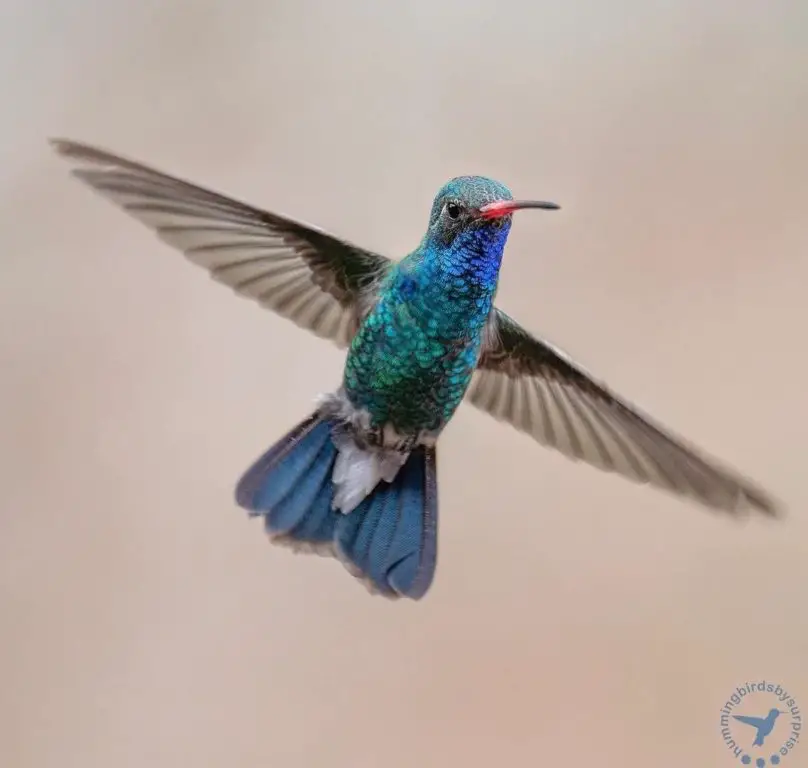
Photo by: hummingbirdsbysuprise
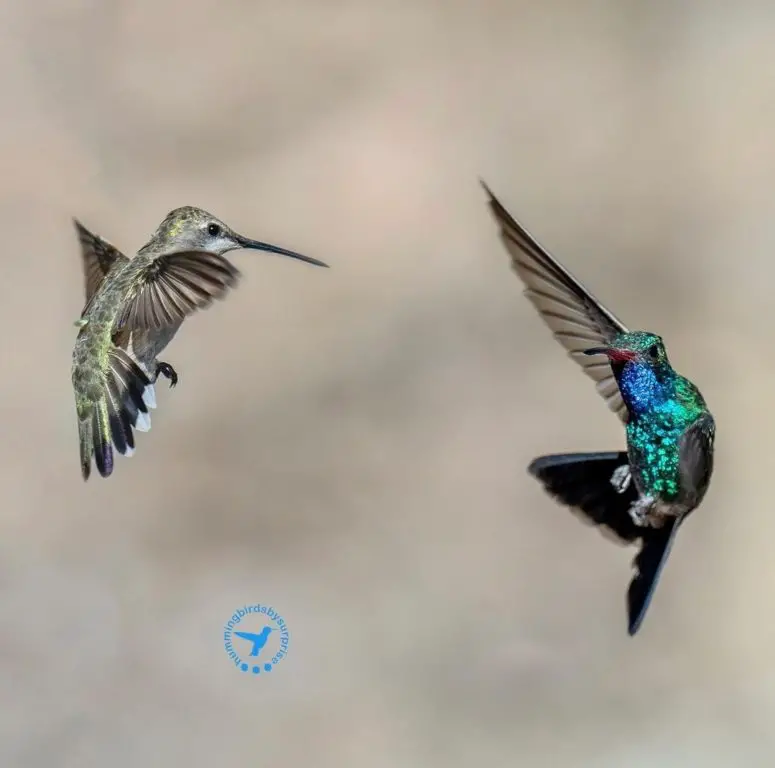
Photo by: hummingbirdsbysuprise
Female Broad-billed hummingbirds are identified with a completely dark bill and a white accent above the eyes.
Both juvenile male and female Broad-billed hummingbirds are predominantly metallic green on their topside with a white underbelly. Their tails are dark in color and forked.
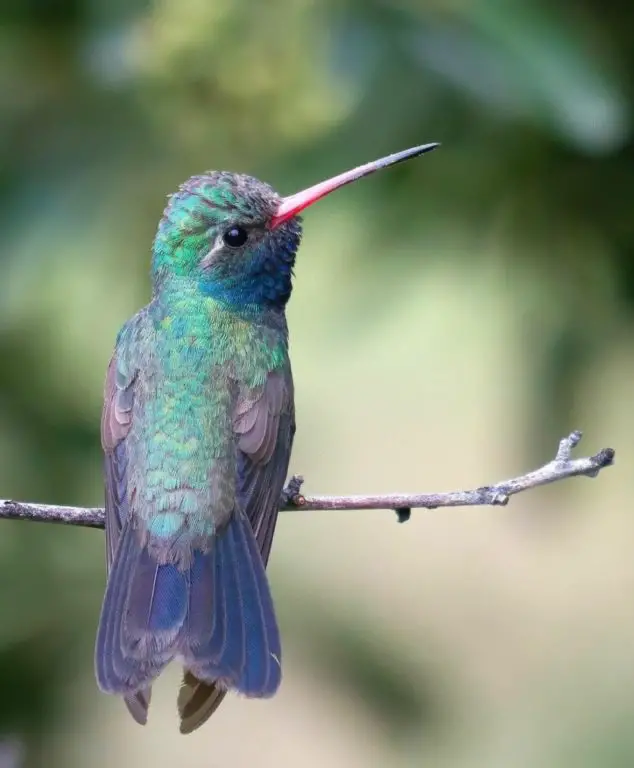
Photo by: Aaron Gomperts

Photo by: hummingbirdsbysuprise
Broad-billed hummingbird nests are distinguished by their lack of decoration with lichens. Instead, these hummingbirds choose to assemble and adorn their nests with grass fibers, bits of leaves and bark while using spider webs to glue and hold the nest together. These nests constructed by the female hang on a single long slender branch.
Astonishingly, unlike other hummingbird population counts, the Broad-billed hummingbird has shown an actual general population increase in recent years but continues to be a vagrant in Georgia.
See pictures of male, female, and juvenile Broad-billed hummingbirds here…..
Hear sounds of Broad-billed hummingbirds here…..
BROAD-TAILED HUMMINGBIRD – (Selsaphoris platycercus)
Conservation Status: Least concerned
Kingdom: Animalia
Phylum: Chordata
Class: Aves
Order: Apodiformes
Family: Trochilidae
Genus: Selsaphoris
Species: S. platycercus
The Broad-tailed hummingbird, winters mainly in Mexico and Guatemala but has been sighted as an accidental, very rare bird in Georgia.
This species consists of a migrant and non-migrant population residing in southern Mexico. The migratory population begins their journey north during springtime between February and late May and will pass through Arizona, Colorado, Wyoming, Idaho and as far north as northern Montana. Therefore, sightings in Georgia though documented are extremely rare.
Once the breeding season is complete, Broad-tailed hummingbirds will once again head south to winter in Mexico and meet up with their non-migrant population.
Male Broad-tailed hummingbirds have an iridescent ruby-red gorget. Both males and females have green topside and pale underbellies with bright white eye rings and broadly rounded tails. Their size is medium build and ranges from 3.3 inches to 3.8 inches in length and weighs 3.6 grams.
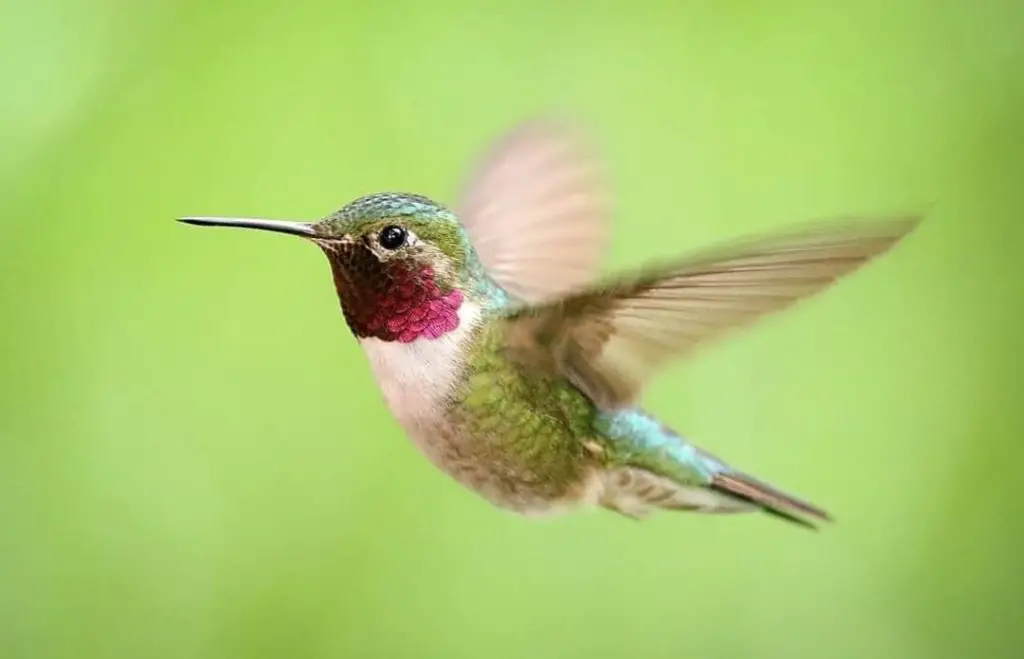
Photo by: bird.whisperer
This species of hummingbird favors habitats in the understory of mature forest woodlands such as pine and oak groves.
Broad-tailed hummingbirds prefer to nest in juniper shrubs or coniferous plants including alder, aspen, cottonwood, scrub oak or willow. All of these have similar superb material properties for constructing a nest. These birds are known to return to the same nesting ground each year roughly 70% of the time.
Their breeding coincides with the timing of when the native flowering plants peak for maximum food resource availability. They are promiscuous and do not form any kind of a pair bond between the male and female birds. The females raise the young alone.
The Broad-tailed hummingbird has suffered a decline in population since the 1990’s, but presently, its population is stable, and has adapted to human habitat encroachment.
See pictures of male, female, and juvenile Broad-tailed hummingbirds here…..
Hear sounds of Broad-tailed hummingbirds here…..
CALLIOPE HUMMINGBIRD – (Selasphorus calliope)
Conservation Status: Least concerned
Kingdom: Animalia
Phylum: Chordata
Class: Aves
Order: Apodiformes
Family: Trochilidae
Genus: Selasphorus
Species: S. calliope
Calliope hummingbirds are named after a Greek mythological muse, who represented poetry and eloquence. Calliope means “beautiful voice” in ancient Greek.
The Calliope hummingbird is an accidental/vagrant winter visitor in Georgia. According to the Georgia Department of Natural Resources, during the winter of 1998-1999 was the first documented sighting of the Calliope. To date there are only one or two maximum sightings per year.
Male Calliope hummingbirds are easily identified by their iridescent purple crown and long striking spaced outline row of feathers that project down the sides of their throats. Like many hummingbirds the backs are metallic green and these birds measure 3 inches in length and weigh 2-3 grams. Male Calliope hummingbirds establish a breeding territory and mate with every available female hummingbird that accepts his courtship.
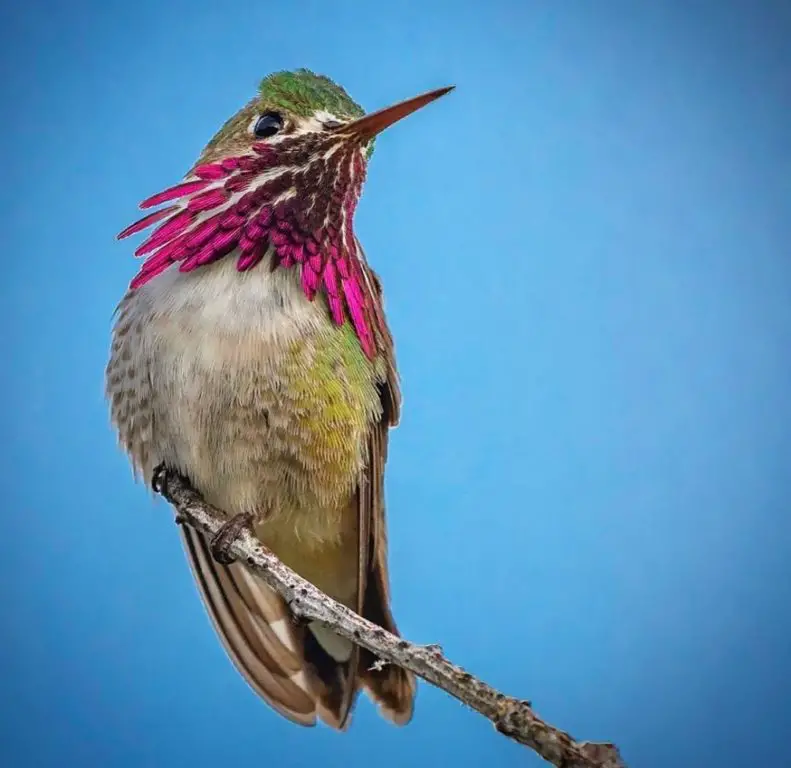
Photo by: sony_alpha_male
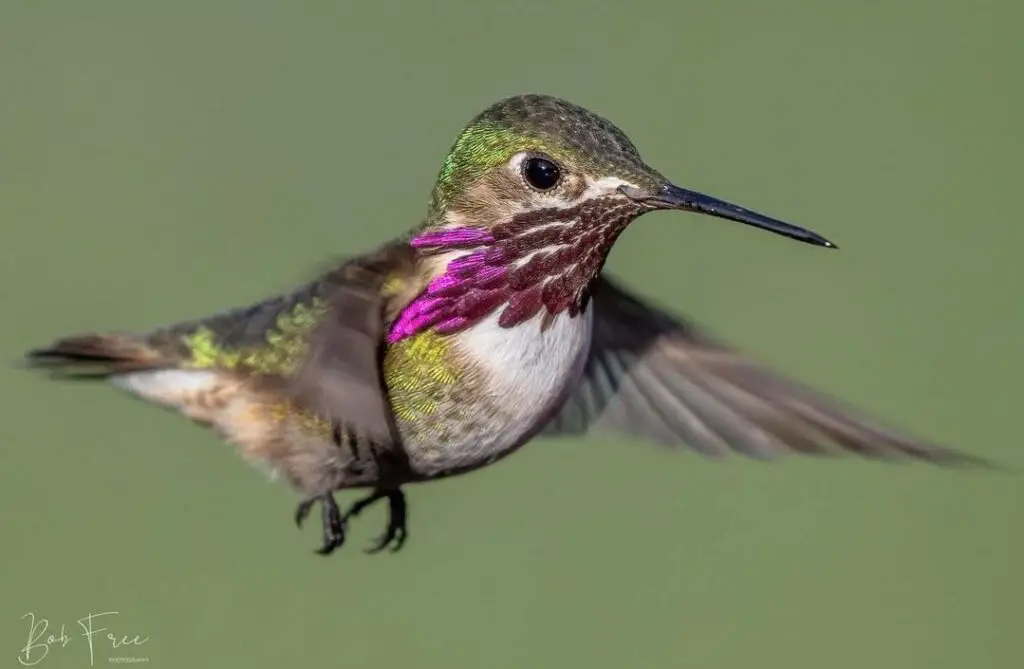
Photo by: Bob Free
Female Calliope hummingbirds have gray-green crowns and buff-colored flanks which are the underbelly or wing of a bird. Females sport dark tails with white tips.
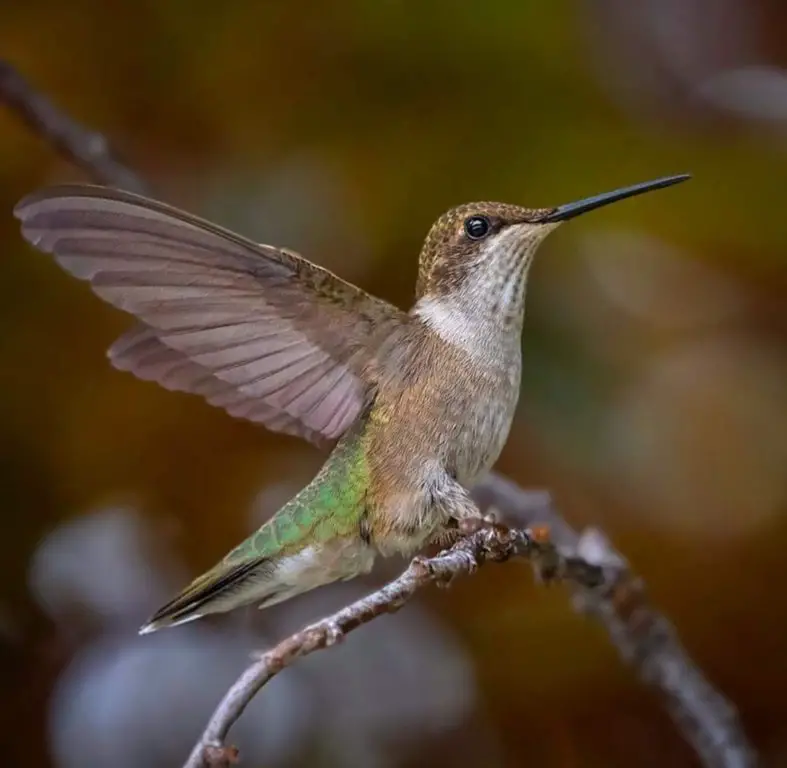
Photo by: sony_alpha_male
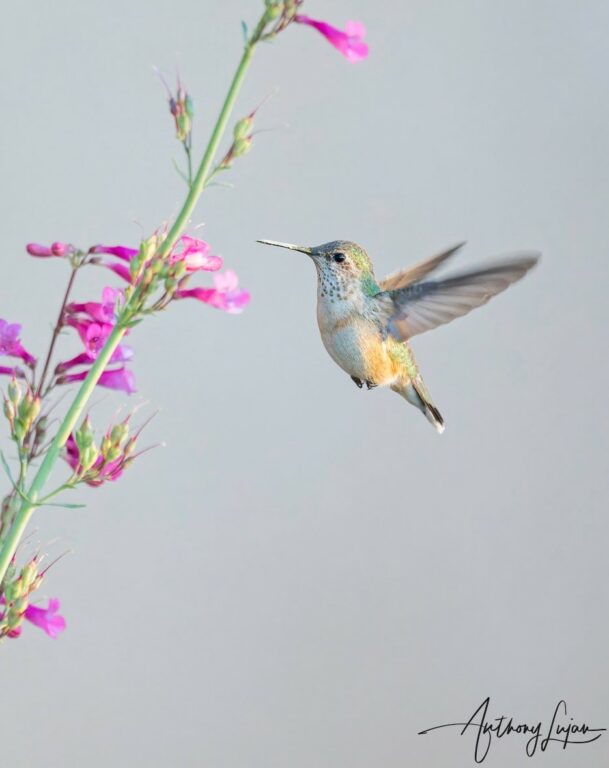
Photo by: Anthony Lujan
Juvenile Calliope hummingbirds, both male and female, look more like adult females until they are differentiated as the male begins to acquire the iridescent feathers that are typical of this species of hummingbird.
During nest construction, the female Calliope will choose tops of pine cones as her building site. She will steal building materials from other bird’s nests to supply her nests with the best available building materials. Therefore, female Calliopes are often chased and attacked and by larger more aggressive species of hummingbirds such as Allen’s and Rufous hummingbirds. To avoid these attacks, the Calliope maintains a relatively low profile in comparison to other species.
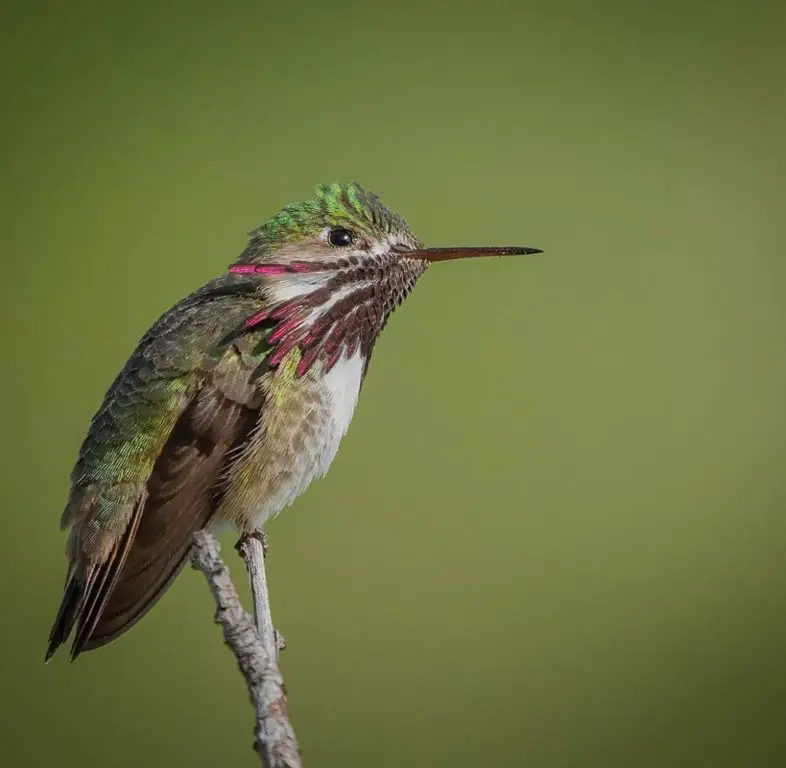
Photo by: sony_alpha_male
Note: His bright throat feathers are slowly coming in.
Baby Calliope hummingbirds are easily identified by their white fluffy feathers that will disappear as they age.
Calliope hummingbirds are the smallest long-distance migratory bird in the world. They tend to breed in the higher elevations of the Rocky Mountains.
Like many hummingbirds, Calliopes communicate not just by their song, but also by manipulating their feathers during flight to make various buzzing noises as a form of language and communication.
Because Calliope hummingbirds have a more restricted wintering range than most hummingbirds, they are particularly vulnerable to habitat loss and natural disasters, such as climate change and wildfires.
See pictures of male, female and juvenile Calliope hummingbirds here…..
Hear sounds of Calliope hummingbirds here…..
GREEN-BREASTED MANGO (Anthracothorax prevostii)
Conservation Status: Least concerned
Kingdom: Animalia
Phylum: Chordata
Class: Aves
Order: Apodiformes
Family: Trochilidae
Genus: Anthracothorax
Species: A. prevostii
The scientific name of the Green-breasted Mango is in commemoration of Florent Prevost, a French naturalist. These hummingbirds are native to Mexico and reside in tropical deciduous forests from Central America all the way down to Panama. They are considered accidental vagrants to Georgia.
To date only one recorded sighting of a juvenile male Green-breasted Mango has been documented in Dublin, Georgia in October 2007.
Male Green-breasted Mango hummingbirds are large in size and feature a long sapphire gorget that stretches below their chest. This hummingbird displays a turquoise crown. Their shoulders and flanks are a dark olive green and the wings and tail are dark purple that can be mistaken to look black depending on the environmental lighting.
The Green-breasted Mango hummingbird’s tail when fanned out ranges from a royal purple mixed with red-orange to magenta colors. Their black beaks are thick and slightly curved downward. Their size ranges from 4 inches to 4.5 inches in length and they weigh 7 grams.
The female and juvenile hummingbirds have a mossy green back with black wings. They sport a dark stripe starting from their throat and reaching past their underbelly. This stripe on their throat can change from black to a midnight bluish green depending on the reflection of the light.
See pictures and hear sounds of Green-breasted Mango hummingbirds here…..
RIVOLI’S HUMMINGBIRD – (Eugenes fulgens)
Conservation Status: Least concerned
Kingdom: Animalia
Phylum: Chordata
Class: Aves
Order: Apodiformes
Family: Trochilidae
Genus: Eugenes
Species: E. Fulgens
The Rivoli’s (pronounced: rivo-lee) hummingbird has undergone several name changes. In 1983 it was changed to the “Magnificent Hummingbird”, then to “Refulgent Hummingbird” only to have the “Rivoli’s Hummingbird” name return in 2017 when the species was split into two variations (Rivoli’s and Talamanca). Rivoli’s Hummingbird is named in honor of Francois Victor Massena, the Duke of Rivoli, by the ornithologist Rene-Primevera Lesson.
To date only two recorded sightings of the Rivoli’s hummingbird have been documented with one sighting during the summer.
The Rivoli’s hummingbirds are normally found in the mountainous areas of Arizona, New Mexico, and Central America, occasionally seen in South Bend, Texas west of Dallas. They have been documented being seen from the end of March to the beginning of October. Preferring to live in ravines while feeding in open meadows these birds will nest in trees overhanging streams and creeks.
Male Rivoli’s hummingbirds are somewhat dark in color except when they are shown in bright daylight, where their violet crown, bright blue-green gorget, and white eyespots are more apparent through iridescence. They are 4.3 to 5.5 inches in length and weigh 6-10 grams. They are the largest hummingbird in Georgia.
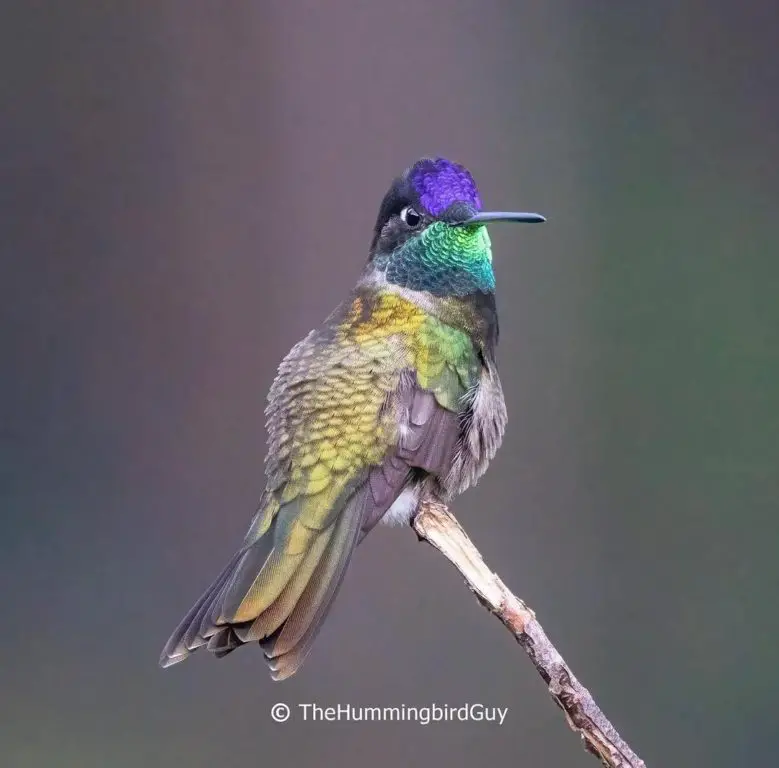
Photo by: thehummingbirdguy
Female Rivoli’s hummingbirds are slightly duller in color than the males showing a bronzy green topside and dull gray underbellies with bright white eye accents.
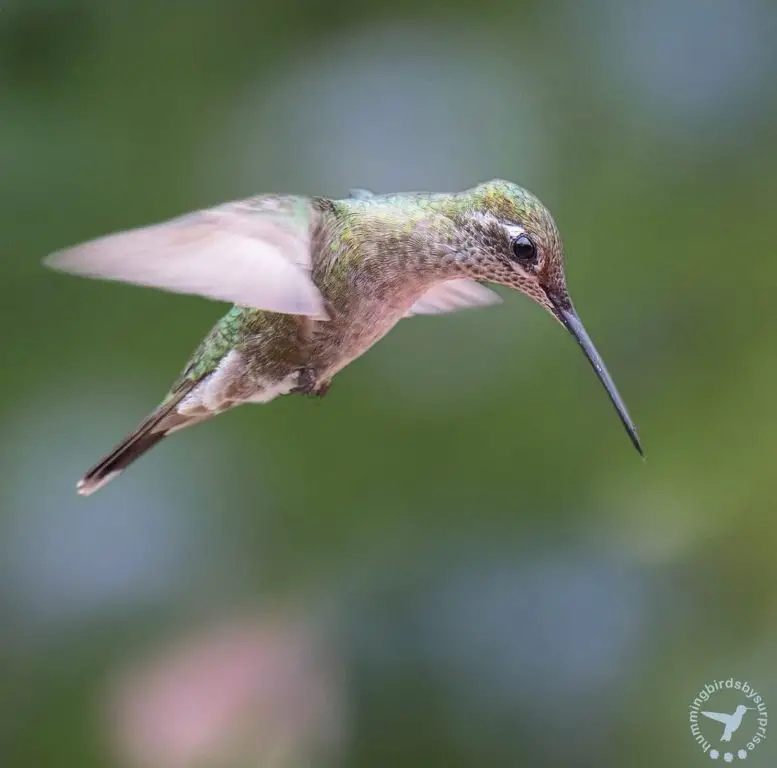
Photo by: Hummingbirdsbysuprise
Juvenile Rivoli’s hummingbirds, both male and female, look more like adult females until they are differentiated as the male begins to acquire the violet crown, bright blue-green gorget, and white eyespots that are typical of this species of hummingbird.
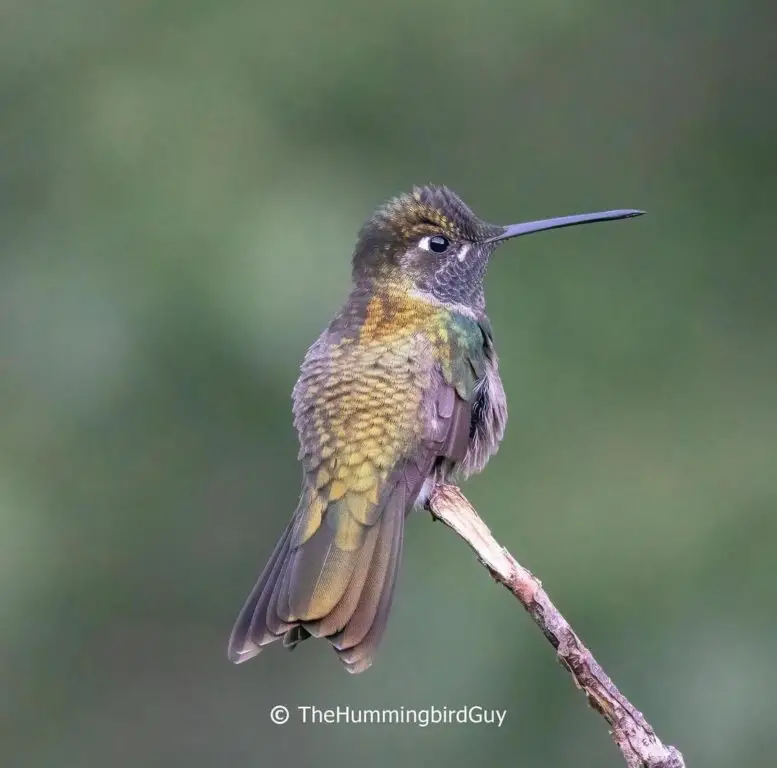
Photo by: thehummingbirdguy
Note: He still displays some white fluffy feathers near his bottom from when he was a baby suggesting he is not a full adult, however is in the later stages of adolescence.
Baby Rivoli’s hummingbirds are easily identified by their white fluffy feathers near their bottom that will disappear as they age.
Their breeding habitat consists of building nests in evergreen coniferous trees such as pine, fir and juniper.
They have the highest recorded heart rate of any living vertebrate ranging from 420 to 1,200 beats per minute.
Rivoli’s hummingbirds are known for hybridizing with Broad-billed and Berylline hummingbirds in the southernmost areas of its habitat range.
See pictures of male, female, and juvenile Rivoli’s hummingbirds here…..
Hear sounds of Rivoli’s hummingbirds here…..
MEXICAN VIOLETEAR (aka GREEN VIOLETEAR) HUMMINGBIRD – (Colibri thalassinus)
Conservation Status: Least concerned
Kingdom: Animalia
Phylum: Chordata
Class: Aves
Order: Apodiformes
Family: Trochilidae
Genus: Colibri
Species: C. thalassinus
The Mexican violetear AKA Green Violetear (pronounced Violet-ear) hummingbird gets its name from the Latin word thalassinus meaning “color of the sea”. These hummingbirds are native to Mexico and are located in tropical deciduous forests of Central America. Only when they migrate and wander north are they considered rare accidental vagrants to Georgia.
According to the Georgia Department of Natural Resources, there has been only 1 verified recorded sighting in southern Georgia in the city of Thomasville in July 2001.
Male Mexican violetear hummingbirds are iridescent green in color with a show of bright violet ear patches on each side of their neck (hence the name “violet-ears”). The tail of this hummingbird is metallic blue-green with bronze central tail feathers that feature a black band underneath. Their size ranges from 3.8 inches to 4.7 inches in length and they weigh 5-6 grams.
Female Mexican violetear hummingbirds usually are less colorful than the males and usually do not have iridescent and distinctive violet ear patches on each side of their neck.
Juvenile Mexican violetear hummingbirds, both male and female, look more like adult females until they are differentiated as the male begins to acquire the iridescent violet ear patches on each side of their neck that are typical of this species of hummingbird.
Baby Mexican violetear hummingbirds are easily identified by their white fluffy feathers near their bottom that will disappear as they age.
These species of hummingbirds are found on the edge of cloud forests from Mexico to Nicaragua where they enjoy a high level of tropical humidity in their environment. This dark hummingbird is commonly seen in forest clearings and edges.
Green-violetear hummingbirds are somewhat nomadic. Scientists do not know much about their migration patterns as they have not been well-studied. But of the data that has been collected, the Green-violetear or Mexican-violetear is typically found in Central Mexico, Central America, and northern South America.
Individual Mexican-violetears are found strayed as far north as Wisconsin, Michigan, and even Canada.
Like many other kinds of hummingbirds, the Green-violetear hummingbirds are solitary nesters. They forage for nectar and insects alone rather than in a flock, but groups of these hummingbirds can be spotted around flowering trees, such as the coffee-shade Inga tree.
See pictures and hear sounds of Mexican violet-ear hummingbirds here…..
Hummingbird Migration in Georgia
Happy Hummingbird Watching!
Backyard Visitors participates in affiliate programs which compensate us for referring traffic.

